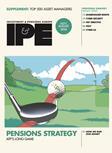It’s strangely quiet in the Belgian pensions market at the moment. Quiet for a market that has developed into one of Europe’s liveliest in the last 10 years.
However, Belgium has more reasons than most countries at the moment to explain the lull in activity.
There is, of course, the overbearing presence of a market heading due south with little sign of a turnaround.
On top of that, though, there are elections just around the corner. And tied up in the final business of the present government is the long-awaited Vandenbroucke Law on industry-wide second pillar pension plans.
The timing of the final discussions on the Vandenbroucke law couldn’t be more crucial either.
The country’s employers and unions have just started their latest round of biannual collective bargaining on wages and employee benefits. For a number, the issue of sector-wide pensions is on the table for the first time.
The net effect of this market volatility and legislative manoeuvring has been to dampen investment activity down to a handful of RFPs and a general battening down of the hatches.
Behind the scenes, however, equity allocations have taken a beating and most Belgian pension funds are below their strategic equity benchmarks. Few funds have sought to rebalance this equity slide, instead opting for the temporary safe haven of cash, and/or a shift into bonds.
Jan Longeval, head of institutional portfolio management at Banque Degroof in Brussels, comments: “A number of pension funds have gone into bonds while equity rebalancing has been put on hold.
“If you looked at equity allocation at the end of last year then it was about 50% of portfolios on average. Now, it is about 40–45%. I would not be surprised to see a few pension funds change their strategic benchmark if things continue as they are.”
Koen De Ryck, managing director at Pragma Consulting, adds that for some funds equity exposure has fallen to 40% or less.
“Not many funds have reduced equity holdings yet, although this will certainly happen if things go on as they are. I think we have still to see what the final figures for Belgian pension fund returns for last year are.”
Preliminary return figures collated by the Belgian Association of Pension Funds (BAPF) put last year’s average at –12.1%.
One reason why Belgian pension funds are perhaps more reluctant to rebalance than elsewhere in Europe is that they tend to have been less impacted at the solvency level than, say, in the Netherlands or UK.
Few occupational plans have taken contributions holidays (although this is possible in law), so they retain some buffer against the current market ill wind.
On top of that Belgian pension plans enjoy a relatively pragmatic relationship with the regulator – in sharp comparison to their Dutch neighbours.
Should a pension plan find itself in funding difficulties the authorities are more likely to suggest a recovery plan with a five-year horizon than take any action that could be detrimental to the scheme.
As Edwin De Boeck, managing director at KBC Asset Management notes: “One reason for this is that the macro economic impact of funded pensions is less dramatic in Belgium than in the Netherlands. We are less affected by the second pillar problems that majority funded systems have.
“There are some pension funds having difficulties, but the bulk still have their reserves intact.”
Nonetheless, as in the rest of Europe, risk is the name of today’s game for Belgian pension funds. This means greater fixed-income exposure, particularly in corporate bonds.
According to Yves Van Langenhove, deputy chief executive officer at Invesco, the current low interest rate environment is pushing institutions to adopt a passive strategy for government bonds, whilst moving up the credit curve into high yield and emerging market debt depending on their risk appetite.
“There is a lot of investment in credits at the moment as a kind of satellite exposure. At the moment I think this is as alternative as it gets in Belgium, because I am not seeing any trend in real estate, and private equity is certainly not an easy sell at the moment. In terms of hedge funds, we’ve heard that some funds may have adopted a straight long-short strategy on some US equity exposure.”
Benoit Fally, deputy managing director at State Street Global Advisors (SSGA), is less convinced about the credit risk appetite of Belgian plans, noting that the plans he has dealt with have all been sticking with predominantly AA rated bonds, and rarely lower.
Additionally, Francis Heymanns, director sales and marketing institutional asset management at Petercam, is less sure that the passive option in government bonds is the right one.
“We still believe that we can deliver outperformance here through active management.”
However, both Fally and Van Langenhove claim that the new kid on the block, the enhanced index product, is picking up good business as investors divert their passive exposures into something with a little more pick-up.
Says Van Langenhove: “We have products that are targeting 1% outperformance and are seeing a lot of interest here as pension funds look to restructure their risk budgets.”
Fally confirms though that the bond play is the ‘alternative’ satellite selection for the majority of Belgian pension funds at present, and captures neatly the quandary for Belgian institutions regarding alternative assets:
“They can’t put enough allocation into alternative assets to justify the exposure and at the same time they are reluctant to dip more than a toe in the water.”
But, Paul Beller, head of institutional business development at KBC, says some capital guaranteed products that are popular in the retail market are gaining increased interest among institutional clients.
“It is difficult to persuade institutions that they might take such an approach in the long run, but without a doubt the protection of downside risk is very much in favour at the moment,” he says.
“The capital guarantee products that are sold tend to be on the fixed income side – people are not keen on equity products like this.” There are some structured products that provide upward potential should interest rates rise, but also give short-term protection against capital losses on the fixed income portfolio. “However, the market is not so sophisticated or large enough for there to be many mandates in this area.”
This idea of capital guarantees, however, is set to become a whole lot more relevant to the Belgian market under the proposed Vandenbroucke law (see page 24).
While few expect industry-wide pensions to be a market that will explode into action overnight, it will undoubtedly continue to preoccupy product providers keen on gaining a foothold in a potentially lucrative arena.
Could this be an area where foreign managers might step in and take a stab at the Belgian market? Perhaps, although it is worth remembering that while the top 10 or so Belgian pension schemes have become some of Europe’s leaders in investment, the bulk are relatively small and their size clearly dictates how they invest. These mid to small sized schemes still run predominantly balanced portfolios and are invested through SICAVS due to an anomaly in Belgium law where they get hit for withholding tax if they invest in segregated mandates.
The Belgian Association of Pension Funds (BAPF) has lobbied hard against this, considering it to be a discriminatory tax law. (Insurance companies are not subject to the same rule.) Others have pointed to the issue of opaque management costs and lack of investment control within SICAV investment. With such significant tranches of Belgian pension assets invested in SICAVS, how does this reflect on their transparency and sound governance?
Ironically, Pragma’s de Ryck points out that the Belgian tax authorities raise very little from the law as it stands, with so many schemes using this fiscal bypass.
Significantly, de Ryck believes that if the tax ruling was removed it would trigger more pension funding from sponsors – in line with what the government is trying to achieve through the Vandenbroucke law. “Psychologically I think it would help,” he comments.
However, Henk Becqauert, cabinet adviser to Frank Vandenbroucke, the Belgian minister of social affairs and pensions, says the issue of withholding tax will not be included in the new pensions law. “This is a difficult and not so pleasant discussion.
“It is also very technical. I thought that maybe three years ago we could create a pension institution that could be used by insurers or pension funds, but with the same taxation rules. The idea was not to change the rules of the insurers or pension funds, because the insurance rules also cover individual life insurance plans and so it is difficult to separate this out.
“The easiest way seemed to create something new. We had a decision in government and then it was blocked by the controlling body of the banking sector. I think this is something that the next government will have to look at.”
Another suggestion doing the rounds in Belgium is the creation of an institutional SICAV, where insurance companies and pension funds would be able to establish a non-quoted unit trust for their pension assets to avoid paying the withholding tax.
Returning though to the issue of investment managers in the market, it’s worth remembering that the Belgian market in total only represents some e15bn – a third of the size of the Irish institutional market. Any house entering the market has to weigh up the opportunity cost carefully.
For the same reasons, the Belgian consultancy market has not really taken off on an Anglo-Saxon trajectory.
Longeval at Banque Degroof, notes: “The Belgian market is tiny. You have the likes of Watson Wyatt, Pragma, Hewitt and KPMG here, with Mercer concentrating on the admin market, but unlike, say, the UK, this is not a market that is populated with advisers. There have been no real arrivals in the market recently. The market is just too narrow.”
The lion’s share of the assets that are up for grabs are managed by Belgium’s big four: Dexia, KBC, Banque Bruxelles Lambert (BBL) and Fortis. All are able to cross-sell asset management and other corporate financial services to Belgian companies and their pension funds.
That is not to say though that these players dominate the market.
Francis Heymanns at Petercam, which runs about e6bn in assets, half of which half is institutional money, believes that the firm’s autonomy is vital in a market where he says interests can be conflicting: “It means we can speak out as an organisation about our investment views, which I believe is important to institutional clients in the current market conditions.
“Also, our focus is on pure asset management in Belgium, which gives up a local servicing priority and a focus on internal growth.”
Similarly, Longeval points out that Degroof manages money, either totally or partially, for some 20–25% of all Belgian pension funds. “We have a historical relationship with Belgian pension funds and see this as a key area for the company.”
Consequently, by the end of March, Degroof Institutional Asset Management (DIAM) will become a separate subsidiary of the bank.
“What we can offer is a consistent value approach as well as specialisations in areas like tactical asset allocation where we believe we can add value. On top of that for global balanced mandates we have beaten the benchmark in the last four years. This still makes up a significant part of the business here.”
Traditionally another aspect that defined the Belgian market was its extremely low fee structure – verging on the charitable – at 5–15 basis points per mandate.
De Boeck at KBC believes that this may have kept competition to a minimum until now, but also flags up an interesting quirk in the market today.
“Paradoxically, it’s possible now to have better fees and margins that we used to have. That’s not to say that margins aren’t low.
“If you have a mandate for e25m and you get 25 basis points that would be considered a lot. But when you consider that we used to work sometimes for five basis points... You need to look closely at whether it’s viable to be a manager in this market.”
Those that have entered the Belgian market – the likes of Vanguard, State Street and Invesco - do appear to have done their homework though. In general they only target the larger Belgian funds, and have doubled up their Brussels’ operations as European hubs for business in the Benelux and Nordic regions.
As Van Langenhove at Invesco notes: “The international managers that are in Belgium are selling their top of the range products where they feel they can justify the normal fee.”
Fally at SSGA believes that the presence of the foreign players is gradually bringing in deeper, more lasting changes though: “This is a market that has always been very open to international asset managers and we believe we can compete on quality of product with the local managers, certainly among the top tier of funds.
“For mid-size and smaller schemes investment decisions are not always performance driven, but this is changing and I believe that this influence from above will eventually filter down.”
Certainly, de Ryck at Pragma believes there is reason for dissatisfaction at present amongst pension funds that still adopt a balanced strategy: “Some of the investment managers in the market have not used the mandates they have been given.
“We have implemented a number of strategic asset allocation bands for mandates for clients where managers had a target weighting in equities along with asymmetric margins on either side so that they could adjust holdings as and when the market condition demanded.
“Unfortunately, very few reduced their equity exposure as they could do and this was the reason for much of the underperformance last year.”
De Ryck also fears that the reported return figures for Belgian funds could be lower than the sample 12.1% provisionally reported by the BAPF, suggesting they may be more in the range of –16–18%.
If De Ryck is correct and investment returns are that low, and if the Belgian government does manage to introduce the Vandenbroucke law in the next few months, it can be said with some certainty that the Belgian institutional market won’t be quiet for very much longer!












No comments yet